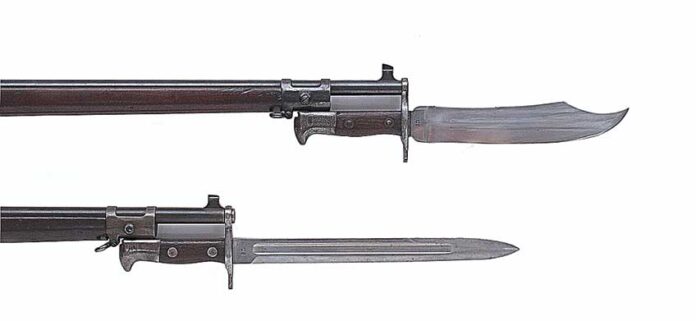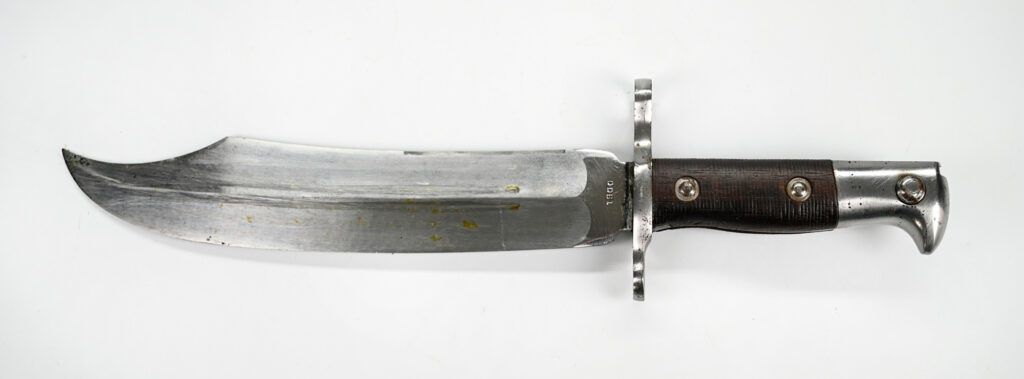
“Underneath our starry flag, Civilize ’em with a Krag.” For a rifle that only served for 11 years or so, it’s kind of impressive that it caught its own mention in a song. The Krag-Jorgensen, also known as the Springfield Model 1892-99 rifle in American use, wasn’t a bad rifle, but Mauser designs quickly outperformed it. It’s rarely talked about today and didn’t get a World War to stand out. It might have been our first repeating rifle and first smokeless rifle, but it wasn’t remarkable. What stood out about the Krag was a pair of experimental bayonets.
The Krag and Bayonets
The first bayonet the Krag had was the classic triangular-type design. The Army realized that was a bit out of date and then moved to adopt a copy of the Swiss knife bayonet. Knife bayonets were common in Europe, and the United States jumped on board. The original Krag bayonet featured a nice 11.5-inch blade, which easily turned the Krag into an effective spear.

The US Army liked the idea of multipurpose tools in this era, and the tools of the infantrymen were mainly rifles and bayonets. A rifle acts like a rifle, and adding a bayonet makes it an effective melee weapon, so naturally, the rifle is already a multitool or murder. The bayonet, though, what does it do besides be a pokey thing at the end of the rifle? It’s also a knife, but apparently that’s not enough.
The Army thought, how can we create a bayonet that can act as a bayonet, as well as a very effective fighting knife? Also, can we make it an entrenching tool? Ooh, and we’ve been in the jungles a lot, so maybe it could be a good brush-clearing tool. That led to the first of the Krag’s prototype bayonets.
Enter The Bowie Bayonet
It was eight years into the Krag’s Service, and America was involved in a few small conflicts with troops stationed all over the world. In 1900, the Army launched its grand plan to release a bowie knife bayonet for the Krag series. As a test run, the Army produced 2,000 bowie knife bayos and sent 1,500 to the Philippines and 500 to Cuba.

The bowie knife idea is as American as apple pie and heart disease. Jim Bowie designed the knife for one task: killing. Jim Bowie wasn’t a good man, but he was good with a knife. He became famous for his prowess with a blade at a time when small pistols weren’t all that reliable. The bowie is a fighting knife, first and foremost.
A fighting knife is great, as a fighting knife. As a bayonet, it wasn’t all that great. The clip-point design meant it couldn’t pierce and penetrate like a real bayo. The design also used a fairly thin and light blade with most of the weight to the rear, which made it crappy for clearing brush.

It achieved one goal, and that goal was looking cool. Looking cool is half the battle, and c’mon, look at it! The other half of the battle is violence, and the bowie knife bayonet sucked at that. However, one good turn deserves another.
The Bolo Bayonet
The bowie variant was a failure, but it helped inspire Captain Hugh Wise to design a bolo bayo. Soldiers realized the Philippine locals had it right with their bolo knives. These blade-heavy tools were perfect for the thick vegetation of the Philippine jungles. Captain Wise went to work designing and building his own bolo bayonet.
He sent his prototype to Springfield Armory and told them this was what troops needed. The Bowie showed they were affable to the idea of radical bayo designs. Springfield Armory built 56 of these knives between 1902 and 1903 and sent them to the Philippines for testing.

The bolo design doesn’t seem like the best bayonet option. The wide blade requires a lot of effort to use and to stab deep. A thinner blade has a bit less drag when used to pierce an enemy, so it can go deeper with less effort. The bolo wasn’t a great bayonet but was reportedly a decent field knife. It was easier to chop the brush and use the knives more like a machete.
Was it a good entrenching tool? I have no idea, and trying to turn a knife into an entrenching tool just seems like a dumb idea. The bolo bayonet could have succeeded, but by 1903, the military was already beginning to adopt the Springfield M1903. There wasn’t a lot of need for a new bayonet for a rifle that was going away sooner than later.
Into the Future
It’s worth mentioning that a Bolo variant of the Springfield M1903 Bayonet was tested. The 1915 design didn’t go anywhere, but it showed the idea wasn’t dead. Trying to make a bayonet that does it all is downright silly. Make a bayonet that’s good as a bayonet, and handy as a knife, and not much more. Still, as far as looks go, the bayonet and bolo bayos score high!



